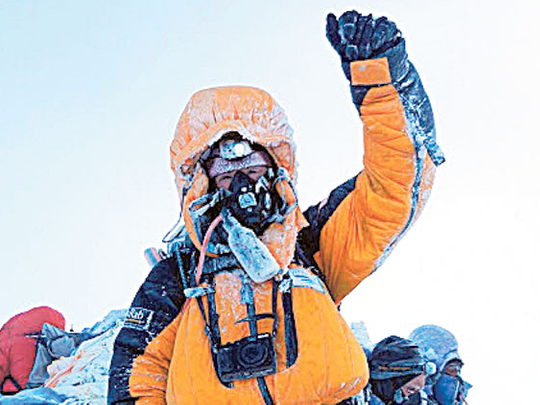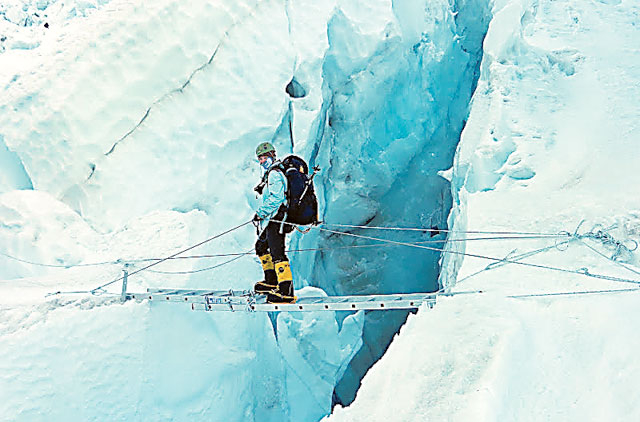
Dubai: You might think sun-drenched Dubai at sea level would be the last place on earth for one to be inspired to conquer the world’s tallest mountains.
But for 19-year-old Leanna Shuttleworth, a field trip five years ago organised by Wellington International School in Dubai would plant the seeds to conquer the top seven mountain peaks around the globe.
In late May, her obsession earned her the honour of reaching the summit of Mount Everest, thus becoming the youngest British female to not only climb the tallest mountain in the world, but also all seven highest peaks on the globe.
The baby steps of her remarkable achievements began on her school trip to Mount Everest Base Camp in 2007 where Shuttleworth enjoyed the 5,500-metre climb to base camp so much that it proved a life-changing turning point.
Shuttleworth quickly signed up for a second school trip to Mount Kilimanjaro in Tanzania and asked her father, Mark Shuttleworth, chief financial officer of du, to join her.
Standing on the summit of Africa’s highest continental peak at 5,963 metres with her father on July 4, 2008, she had achieved the first of many high-altitude personal goals to come.
Her father then agreed to accompany her in her push to conquer all seven of highest peaks in the world and by 2009 she had reached the summit of Mount Elbrus, Russia, at 5,633 metres.
In 2010, the father-daughter duo summited Mount Denali in Alaska at 6,195 metres as well as Mount Aconcaua in Argentina at 6,962 metres.
Last year, the Shuttleworths bested Vinson Massif in Antarctica at a height of 4,897 metres as well as Mount Kosciusko topping out at 2,228 metres in Australia. With six summits to her credit, there lay only one final challenge to surmount — the grand daddy of all mountaineering conquests — Mount Everest, topping out at a dizzying 8,848 metres from ground level in Nepal.
As the highest place on the globe, the Everest summit is the ultimate challenge in the mountain-climbing world, made famous by Sir Edmund Hillary and Tenzing Norgay who were the first to reach the top in May 29, 1953.
Prepared to go for it
In an interview with Gulf News following her return to her Dubai home last week, Shuttleworth recalled flying in to Lukla, Nepal, on April 2 en route to Everest.
“It was exciting and it was very scary at the same time. I was finally going to go for it.”
On May 15, accompanied by her father and her mountaineering guide team, Shuttleworth set out for the top.
The first big challenge ahead was to successfully negotiate the extremely dangerous Khumbu Icefall with its moving ice flows where crevices can suddenly open. She crossed and reached Camp 1 before setting out the next day for Camp 2.
One of the scariest sections of Everest awaited on May 16 en route to Camp 3 as Shuttleworth scaled what is known as Lhotse Face, an extremely steep cliff face that challenges the most seasoned climbers.
“There was trouble on the Lhotse Face…there was danger of rocks falling and a couple of people were hit by falling rocks [from above]. We used a route from the ‘80s on the side,” she said. “There were no footholds so it was very hard work.”
Once safely at Camp 3, Shuttleworth switched to breathing bottled oxygen 24/7 from four-kilo oxygen tanks that would stay on for the remainder of the trip to offset the lack of oxygen at more than 7,400 metres elevation.
Oxygen depletion can lead to serious high-altitude sickness and eventual death if climbers aren’t properly kitted out for the summit climb at this elevation, she said.
On May 18, the hike up to Camp 4 was one of the best days of her summiting experience on Everest and for about 200 other climbers who were also making the push up the mountain after waiting for a good weather window to open.
When the Shuttleworths arrived at Camp 4, hundreds of others were also on site and preparing to push ahead to the top as soon as possible given that all of the ascending climbing ropes were now affixed to the mountain by advance teams in preparation for the first wave of climbers this year.
“You can’t summit until the lines are fixed,” Shuttleworth said.]
Decision time
It was at Camp 4 where father and daughter were faced with a difficult decision that would ultimately affect the rest of the upward adventure on the slopes.
Weather forecasts predicted that the first available weather window would open on May 19 and a second weather window would only open on May 25, six days later.
Hundreds of climbers didn’t wait it out at Camp 4 and decided to push through to take advantage of better weather awaiting the crowds moving up the mountain, a decision that would claim the lives of four climbers within the next 24 hours.
The Shuttleworths, however, decided to stay overnight and conserve their energy for the last final push of more than 600 metres to the top of the world’s tallest mountain.
“We aimed to summit on May 20, we were the only people who waited for a day,” Shuttleworth said, noting that Camp 4 lies at about 8,000 metres and is the last pit stop on the upward trek.
“It’s really not a nice place for camping,” she said, adding it was difficult to sleep with high winds buffeting the pup tent and the cold creeping inside. After some brief shut-eye, Shuttleworth took her first steps toward the last leg of her seven-summit challenge.
When Shuttleworth left Camp 4 for the summit, she knew “she only had one shot because of the limited oxygen supply.”
In complete darkness, Shuttleworth first navigated the ice bands strapping the mountainside before she arrived at a triangular rock face and scaled the natural features skyward.
After about four of leaving camp, she reached what’s called “the balcony,” before “walking along the southeast ridge where we hit snow and ice.”
The climb continued on to the south summit and once over, Shuttleworth was a little unnerved on what’s called the summit ridge, a point on the mountain where only kilometres of air lie beneath on both sides, straight down. Shuttleworth reached the Hillary Step, “probably the most difficult part of it, you rock-climb over this rock step. This is the big obstacle.”
Once over, Shuttleworth walked for about another 30 minutes and reached the peak at 5.50am on May 20, her father standing beside her.
The winds were whipping at 100 km/h and the temperature was -50C.
Her dream achieved, Shuttleworth became the youngest British female to summit Mount Everest and complete the Seven Summits.
Oddly, there was no Eureka moment for the teen literally standing on top of the world.
“To be honest, it didn’t really hit me,” she said. “We didn’t have a good view, we were surrounded by clouds and bad weather. I was covered with ice, I couldn’t get into my water, everything was frozen. “
In that moment, she realised “that I was only half way,” that she still had to climb all the way back down the mountain.
Emotional climb
Three weeks later, Shuttleworth is still sorting through the emotions she experienced on the climb ranging from a sense of self-accomplishment to the knowledge that four people who were not part of her climbing team died the day before she made her ascent.
During her reach for the skies, Shuttleworth passed one man on the mountain in the distance rocking back and forth, and at another point she had to climb around the body of a Canadian-Nepalese woman, Shriya Shah-Klorfine, 33, who had died on the descent. Her team tried to help but to no avail. “It makes death in itself closer to home,” Shuttleworth said. “It makes you want to live life to the fullest.”
Being exposed to all forms of adversity on the Everest climb has made her stronger, but not necessarily prouder. “I expected that it would have me feel prouder but it hasn’t,” she said. “It’s made me feel more self-conscious.”
One lesson Shuttleworth has taken from her incredible accomplishment on Everest is that “life is short” and that personal dreams are a precious commodity. “I’m hoping this will help other women follow their dreams no matter how vain they seem,” she said.













